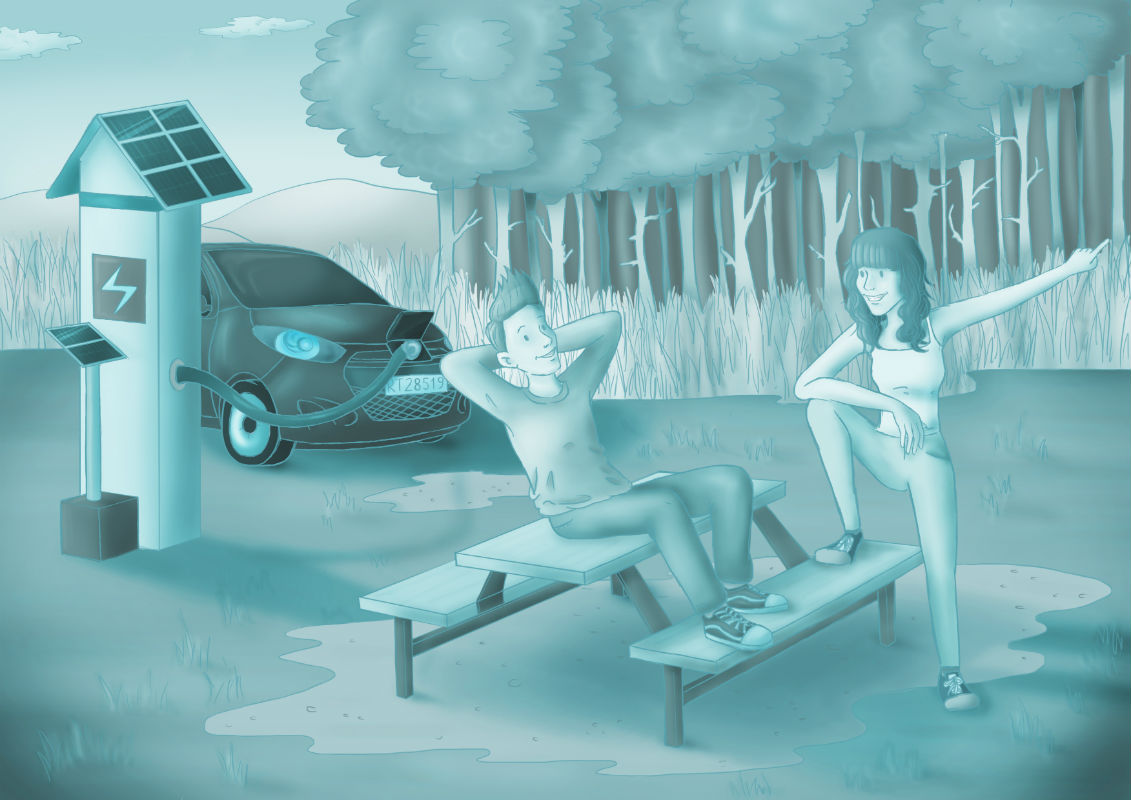Batteries

Batteries Recharging
“We need to stop at a charging station” Lily announced casually, leaving the Soleil Highway and joining the European Route E15. The two friends were leaving Paris and going to Como, the hometown of Alessandro Volta, the inventor of batteries.
“Why didn’t you say this earlier?” Max complained, watching the empty road in front of them. “We must have passed at least three charging stations while in the city”. Lily kept driving calmly. “We will find one on our way” she reassured him.
Half an hour later, just after passing Fontainebleau, they found an on-street car charging station and Lily stopped. They both got out and put the car’s plug in the socket. “Fifteen minutes until it’s fully charged” announced Lily. “What? Back home we have a rapid mode and it does in half time” Max said. “What’s the rush?” Lily asked. “Let’s have a walk around; the nature is so beautiful here. There is a forest close by”.
Max passed on the suggestion as he also wanted to charge his laptop somewhere. Lily said that the electric cars’ charging station wasn’t suitable for charging any other device. Max argued that the basic principle was the same.
Batteries all do the same thing: they convert the chemical energy stored in them into electrical energy.
They all have two terminals, a positive one and a negative one, called electrodes that are made of special materials. There is also a material separating them, the electrolyte. Electrolytes have a special ability: they contain many charges that can move within them. The positive charges go to one electrode and the negative charges to the other, because of a chemical reaction that takes place. This means that inside a battery we have a directed flow of electric charges. The electrical current that gives power to a device, like a laptop, is the continuation of this flow outside the battery, through a wire.
The battery is exhausted when all the charges of the electrolyte have reached their destination on the electrodes. This is when all its available chemical energy is consumed.
While charging, a battery takes electrical power from the socket to convert it back into chemical energy. The charges that enter the electrolyte move now in opposite directions and electrical energy is consumed to build up chemical energy.
Depending on the properties of the materials that the batteries are made of, their energy capacity changes, because some materials can store more chemical energy than others. The element that has been used widely for carrying and storing the electric charges inside the batteries is lithium. Lithium however is not a common material. Advanced materials have decreased the charging time and have replaced materials that were rare on our planet, like lithium, or very toxic, like cadmium, lead or mercury. New batteries have electrodes that are made of carbon-based nanomaterials like carbon nanotubes and are leakage-free because charge-conducting polymers replaced all their liquid parts.
“These are all great” Lily started “but how do they bring you to the conclusion that you can charge your laptop here?”
“Same process, same materials, why not?” Max insisted, secretly checking there were only five minutes left for full charge.
“Because this charger would burn your laptop, that’s why! This source is too strong. The voltage is huge!”
“What’s the voltage?” Max asked innocently.
Lily paused, wondering if he was kidding her and then decided to answer. “It is basically the tendency of electric charges to move between two points. Between the two electrodes we were talking about. If we imagine the electrical current to be water flowing in a river, the voltage is the height difference between 2 points. It makes the water flow in a certain direction, like a waterfall does. The height difference that is used to charge your laptop is 220 Volts. The height difference that is now charging our car is more than 500 Volts. Your laptop will be destroyed; it can’t hold so much power”.
“Oh, so it is due to this high voltage that our car is already charged?” Max asked smirking.
Lily suddenly realised he was teasing her, all this time trying to escape a walk in the forest. She started walking towards the woods, while Max yelled at her “Wait! The car’s battery is fully charged! Come back! We can always go for a walk at the next charging station… after 800 kilometres!”
